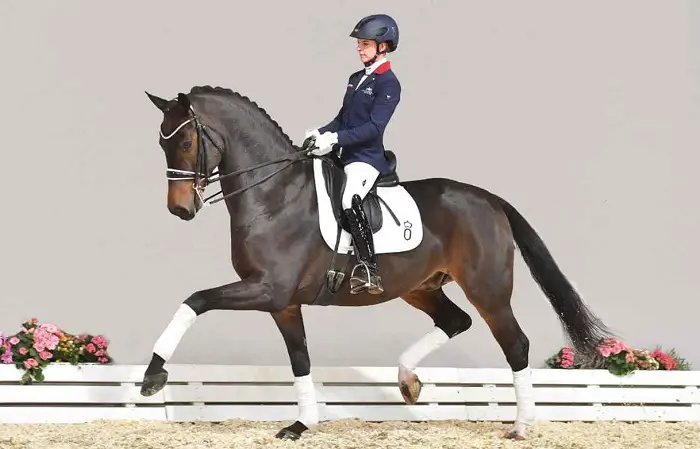English horse riding, also known as English-style riding or simply English riding, is a style of horseback riding that originated in Europe and is commonly practiced in many parts of the world today, including North America, Europe, and Australia. English Horseback riding is characterized by distinct techniques, equipment, and attire.
The Key Features of English Riding Include
- Equipment: English riding typically involves using a close-contact saddle, which is smaller and lighter than Western saddles. The saddle allows the rider to have close contact with the horse, facilitating communication and cues. English bridles often include a noseband, snaffle bit, and sometimes a curb bit, depending on the discipline and level of the rider.
- Attire: Riders usually wear tall boots, breeches or jodhpurs, and a fitted shirt or show coat. Helmets are commonly worn for safety, especially in formal competitions. In some disciplines, such as dressage and show jumping, riders also wear gloves and may wear a protective vest.
- Techniques: English riding emphasizes a balanced and controlled seat, with the rider sitting upright and close to the horse’s center of gravity. Riders use subtle aids, including weight shifts, leg pressure, and rein cues, to communicate with the horse. The goal is to maintain harmony and partnership with the horse while performing various maneuvers, such as jumping fences, executing dressage movements, or navigating obstacles in eventing.
Different Types of English Horseback Riding
English horse riding encompasses various disciplines with specific techniques, rules, and objectives. Here are some of the different types of English horse riding disciplines:
- Dressage:
- Dressage is often called “horse ballet” and focuses on developing harmony, precision, and grace between horse and rider.
- Riders perform predetermined movements, known as tests or patterns, at different difficulty levels.
- Movements include circles, serpentines, changes of direction, lateral movements, and collection and extension of gaits.
- Judges assess the horse’s obedience, suppleness, balance, and responsiveness to the rider’s aids.
- Show Jumping:
- Show jumping involves guiding a horse through a series of jumps within an arena in the fastest time possible without knocking down any obstacles.
- Courses typically consist of verticals, oxers, combinations, and related distances.
- Riders must demonstrate effective communication, balance, and precision while navigating the course.
- Faults are incurred for knocking down rails, refusals, and exceeding the time allowed.
- Eventing:
- Eventing, also known as horse trials or three-day eventing, is a multi-phase competition that tests the horse and rider’s versatility and athleticism.
- The three phases include dressage, cross-country jumping, and show jumping.
- Dressage assesses the horse’s obedience, suppleness, and precision.
- Cross-country involves navigating natural obstacles at speed while maintaining control and balance.
- Show jumping tests the horse’s ability to jump cleanly and accurately over a series of fences in an arena.
- Hunter/Jumper:
- Hunter/jumper competitions focus on the horse’s ability to jump fences cleanly and smoothly while maintaining a steady, rhythmic pace.
- Hunter classes emphasize style, form, and consistency over fences, emphasizing smoothness and evenness of pace.
- Jumper classes prioritize speed and agility, with riders aiming to complete the course in the fastest time possible without knocking down rails.
- Courses typically include a variety of jumps, such as verticals, oxers, combinations, and related distances.
- Equitation:
- Equitation classes judge the rider’s form, position, and effectiveness of aids in performing various maneuvers.
- Riders’ ability to maintain a balanced, correct position while communicating effectively with the horse is evaluated.
- Equitation classes may include flatwork, jumping, and pattern or medal classes.
These are just a few examples of the different types of English horse riding disciplines. Each discipline offers unique challenges and opportunities for riders to develop their skills and form a strong partnerships with their horse.
Concluding Remarks on English Horse Riding
English horseback riding offers a diverse array of disciplines, each with its unique challenges and rewards. Whether pursuing the precision of dressage, the thrill of show jumping, the versatility of eventing, the elegance of hunter/jumper, or the finesse of equitation, riders have numerous opportunities to develop their skills and forge a strong partnership with their equine partners.
At its core, English horse riding emphasizes harmony, balance, and communication between horse and rider. Riders learn to communicate subtly with their horses through aids such as weight shifts, leg pressure, and rein cues, fostering a deep connection and mutual understanding.
The discipline and dedication required in English horse riding contribute to athletic achievement and cultivate valuable qualities such as patience, perseverance, and respect for the horse. Riders must continuously strive to improve their technique, adapt to new challenges, and maintain a commitment to the well-being and welfare of their horses.
Whether competing in high-stakes competitions or enjoying leisurely rides through the countryside, English horse riding offers a fulfilling journey of skill development, camaraderie, and appreciation for the beauty and grace of the equestrian sport. It is a pursuit that fosters lifelong learning, personal growth, and a profound bond between horse and rider.
